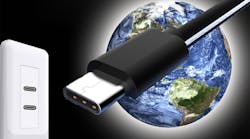USB-C Makes Compelling Case as EU Moves Toward Single Charging Standard
In January, members of the European Parliament voted to recommend a single, universal charger for all mobile phones and portable devices sold in Europe. By a 550 to 12 vote, they argued that standardization on a single charger would not only reduce e-waste, but also be more cost-effective for consumers. What’s more, a group that champions environmental interests across the EU, named the European Environmental Citizens’ Organization for Standardization, is recommending that USB-C become that single-cable standard.
USB-C is the “Holy Grail” of wired connectivity. It offers bidirectional data and power, and a tiny, orientation-agnostic connector that’s the same on both ends of the cord. And, because it carries up to 100 W of power, USB-C can truly become the one connector for any type of electronic device with a power adapter.
To illustrate the impact that a one-cord standard could have, consider the fact that the world ships more than one million tons of power adapters with consumer electronic devices each year, according to data from the Global E-Waste Monitor. Not only would such a policy significantly slash e-waste, but it would also help both consumers and manufacturers alike.
A Winning Scenario
Standardization on a single connector means consumers share and reuse power adapters for all of their electronic devices. Imagine the benefit of having to carry only one charger for your notebook computer, tablet, smartphone, camera, and electric razor while traveling. Meanwhile, manufacturers can consolidate dozens of power-adapter designs into a single type. This could help streamline their supply chain and reduce inventory risk. Over the long term, manufacturers could even offer consumers the opportunity to opt out of receiving a power adapter with their product purchase. It’s truly a “win-win-win” scenario.
Some considerations are being given to standardizing on other charging technologies, including MicroUSB or even wireless. But only USB-C offers up to 100 W of power and can carry data through a single connection. Another reason for USB-C’s appeal is that more than half of all new smartphones already have USB-C on them.
The European Commission is expected to begin considering next legislative steps on this single-charger initiative in the coming months. Even with the directive focusing solely on the EU, it stands to significantly reduce the more than 51,000 metric tons of e-waste produced there annually.
Cypress is a market leader in USB-C and has been helping early adopters bring their connected products to market for four years now. This includes the top-tier brands in every vertical market: smartphones, tablets, and personal computers. Today, more than two billion devices are shipping annually with USB-C with power delivery on board. Now the USB-C trend is beginning to spill over into other markets, including consumer goods, industrial, and automotive.
Designers interested in exploring USB-C with power delivery for their products can check out our Barrel Connector Replacement Kit. This $25 kit supports all USB-C power adapters on the market; no firmware development is required. Though it’s deceivingly simple to use, the BCR kit carries the maturity of Cypress’ USB power-delivery solutions over the past four years, with more than 1,000 customers validating the technology. For more information about our USB-C technology, please visit www.cypress.com/usb-c.
Mark Fu is Senior Director of Marketing, USB Division, at Cypress Semiconductor.
